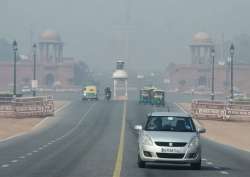Two days after Diwali, air quality 'very poor' in Delhi
Data released by the Central Pollution Control Board (CPCB) showed that air quality in the national capital remained "very poor", two days after Diwali.

The Supreme Court-imposed ban on cracker sale does not appear to have done much good to the national capital, as the air quality data released on Saturday showed similar pollutant and particulate matter levels as the post-Diwali period last year.
Data released by the Central Pollution Control Board (CPCB) showed that air quality in the national capital remained "very poor", two days after Diwali.
According to the CPCB, the Air Quality Index (AQI) touched the figure of 389 on Saturday, which comes under the "very poor" category. The air quality index for Delhi was same on November 1, 2016 -- two days after Diwali.
According to Mahesh Palawat, Director of private weather forecaster Skymet, it is due to calmness in wind speed as compared to last year.
"Last year, wind blowing at a higher speed played a crucial role in improving air quality after Diwali. But this year, wind is blowing at a speed less than 10 km per hour and therefore is not able to suspend particulate matters' spread around us," Palawat said.
However, he predicted that things would improve in the coming days as there were chances of rise in wind speed.
"Coincidentally, the air quality index two days after Diwali remains the same as last year," Vivek Chattopadhyaya, air quality expert at the Centre for Science and Environment (CSE), told IANS, adding that weather also played a crucial role in air quality.
However, he pointed out that an increase in number of monitoring stations over the last one year might also have contributed to recording higher level of pollution.
However, he said compared to last year, there was slight improvement in the visibility and air quality index post Diwali and for this, "credit goes to the Supreme Court which has banned the sale of firecrackers".
"There were six monitoring stations in 2016, while this year it is 16," he said.
He cited October 21, 2016's air quality index which was 264, falling under "poor category".
High humidity, low wind speed and low temperatures meant the pollutants hovered very close to the surface and could not be dispersed, he added.
The Supreme Court ban on sale of firecrackers did not prevent people from lighting sparklers, rockets and loud Diwali "bombs" though the volume was lower than previous years. Some people claimed to have travelled out of the city or shopped online to buy firecrackers, while many claimed they used last year's leftover stock to celebrate Diwali.
The court on October 9 affirmed the ban it had imposed on the sale of firecrackers in Delhi and National Capital Region (NCR). The court said the ban would be in effect till November 1.
Expressing concern over poor implementation of the Supreme Court ban on the sale of fire crackers in Delhi-NCR, industry chamber Assocham on Saturday said ensuring a clean environment should be a combined responsibility of the Centre, the state governments, civil society and public at large and not of the apex court alone.
"The economic interest of the traders and the manufacturers was involved; but once the Supreme Court had banned sale of firecrackers, the enforcement of the order should have been ensured by the Union Environment Ministry, Delhi government and the state governments of Uttar Pradesh and Haryana in entire NCR," said D.S. Rawat, Secretary General, ASSOCHAM.